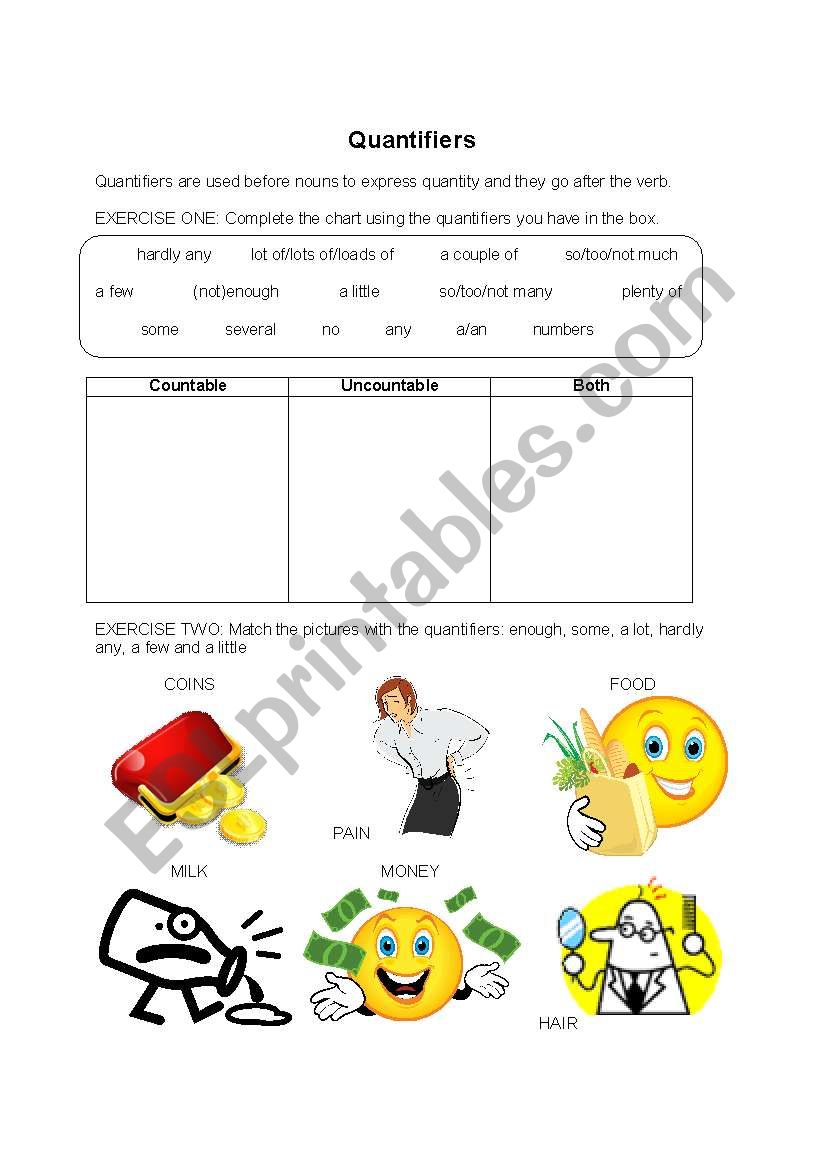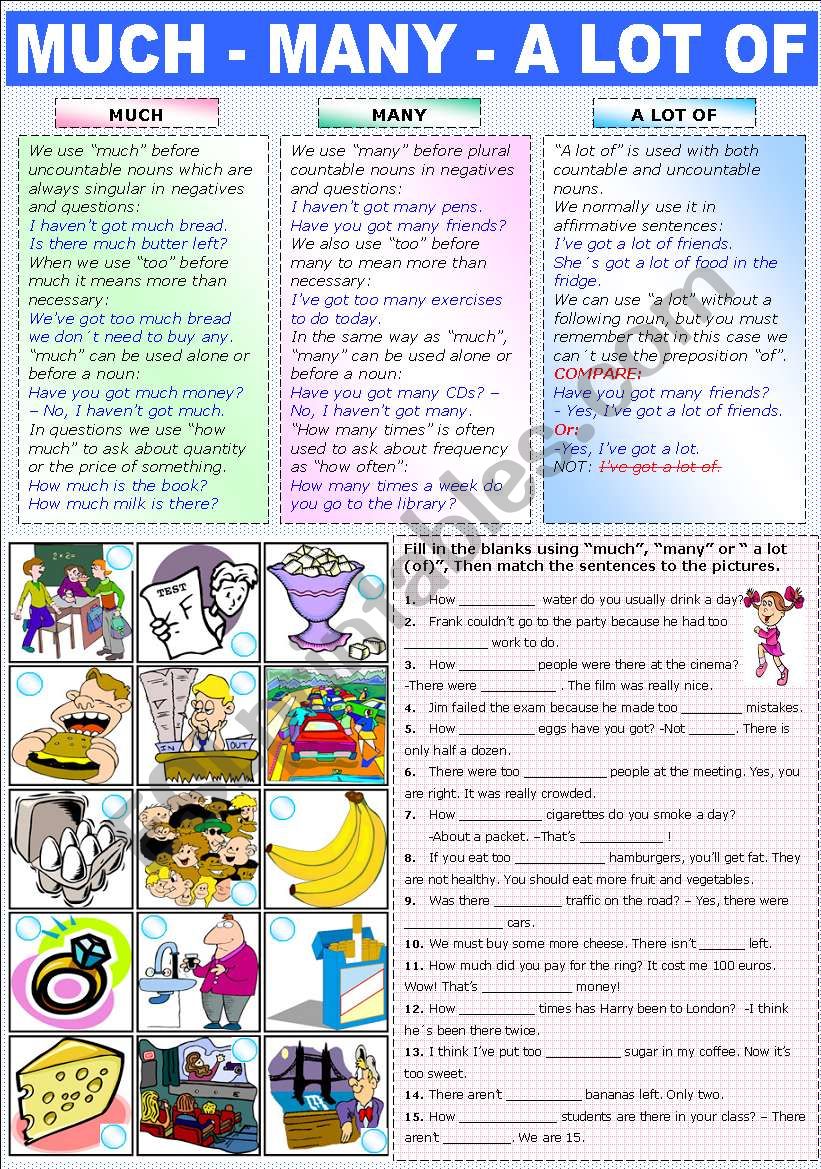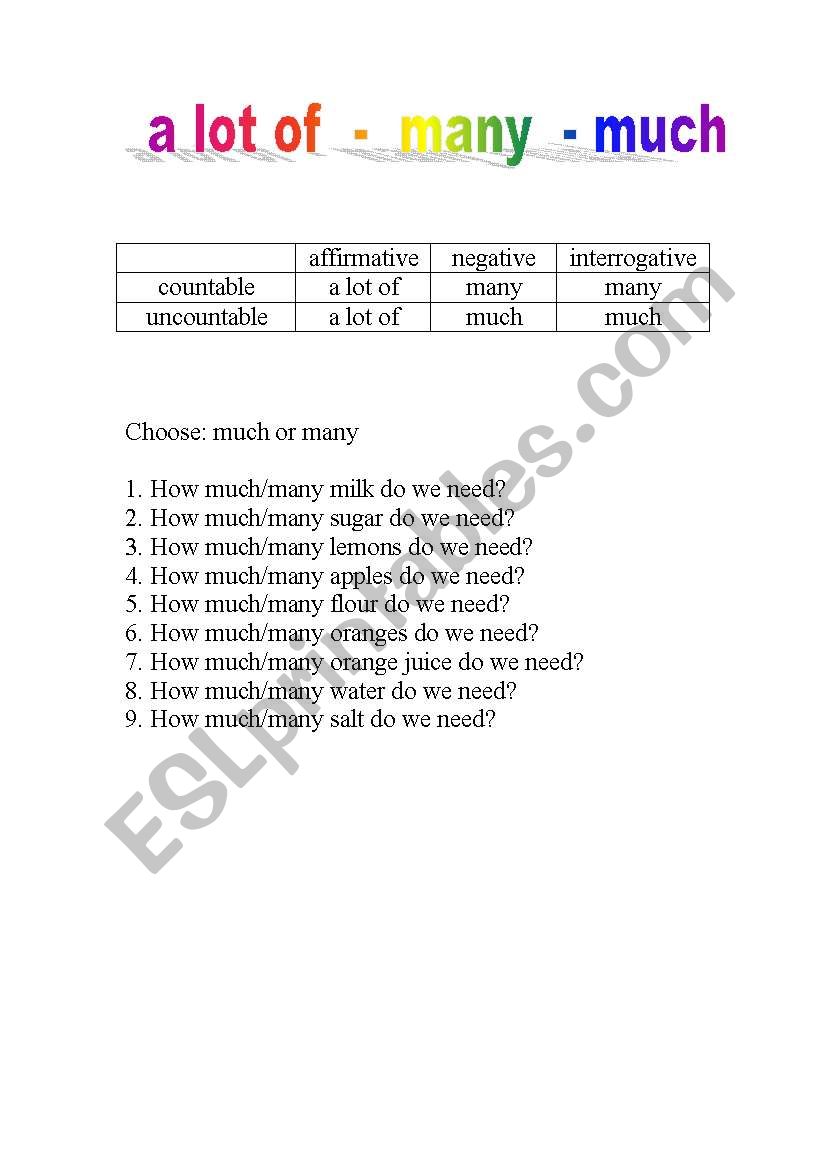
Mastering Much, Many, and A Lot of: The Indispensable Role of Targeted Worksheets
Quantifiers are the subtle yet crucial elements in English grammar that allow us to express quantity or amount. They are the tools that transform vague statements into precise and meaningful expressions, differentiating between "some water" and "a lot of water," or "few books" and "many books." Among the most fundamental and frequently used quantifiers are "much," "many," and "a lot of." While seemingly simple, their correct application often poses a significant challenge for English language learners. This is precisely where the power of well-designed Quantifiers much many a lot of worksheets comes into play, offering structured practice essential for true mastery.
The Significance of Quantifiers in English Communication
At its core, language is about conveying meaning effectively. Quantifiers are vital because they add a layer of specificity that can drastically alter the interpretation of a sentence. Imagine trying to explain your weekend without them: "I saw people at the park and had fun." Compare that to: "I saw many people at the park and had a lot of fun." The second sentence provides a clearer, more vivid picture.

Understanding and correctly using quantifiers like "much," "many," and "a lot of" is not merely about grammatical correctness; it’s about achieving clarity, avoiding misunderstanding, and sounding natural in English. Misusing them can lead to awkward phrasing or, worse, miscommunication. For instance, saying "I don’t have much friends" instead of "I don’t have many friends" immediately flags a non-native speaker and can sound incorrect to an ear accustomed to standard English. Therefore, dedicated practice through Quantifiers much many a lot of worksheets is not just beneficial, but truly indispensable for language learners at all levels.

Deconstructing Much, Many, and A Lot of

Before delving into the specifics of worksheets, let’s briefly review the core rules governing these three essential quantifiers:

1. Much: For Uncountable Nouns

"Much" is primarily used with uncountable nouns. Uncountable nouns refer to things that cannot be counted individually, such as liquids (water, milk, coffee), abstract concepts (information, advice, happiness), materials (wood, metal, plastic), or general substances (rice, sugar, bread).
Key Usage Points for "Much":
- Negatives: Most commonly used in negative sentences.
- Example: "I don’t have much time." (Time is uncountable)
- Example: "There isn’t much sugar left." (Sugar is uncountable)


- Questions: Often used in questions, especially formal ones.

- Example: "How much money do you need?" (Money is uncountable)
- Example: "Is there much progress on the project?" (Progress is uncountable)

- Affirmative (Less Common): While generally avoided in affirmative sentences in casual English, it can appear in more formal or literary contexts, or with "too" or "so."
- Example: "She has much experience in this field." (Formal)
- Example: "There’s too much noise in here."
2. Many: For Countable Nouns
"Many" is used with countable nouns. Countable nouns refer to things that can be counted individually and have both singular and plural forms (e.g., apple/apples, book/books, car/cars, person/people).
Key Usage Points for "Many":
- Negatives: Frequently used in negative sentences.
- Example: "I don’t have many friends here." (Friends are countable)
- Example: "There aren’t many options left." (Options are countable)
- Questions: Very common in questions.
- Example: "How many books did you read?" (Books are countable)
- Example: "Are there many students in the class?" (Students are countable)
- Affirmative (Less Common): Similar to "much," "many" is less common in affirmative sentences in everyday spoken English, but acceptable in formal contexts or with "too" or "so."
- Example: "Many people attended the conference." (Formal)
- Example: "There were too many mistakes."
3. A Lot of / Lots of: The Versatile All-Rounder
"A lot of" (and its slightly more informal variant "lots of") is the most versatile of the three, as it can be used with both countable and uncountable nouns. This flexibility makes it a very common and natural choice in everyday conversation.
Key Usage Points for "A Lot of / Lots of":
- Affirmative: Most commonly used in affirmative sentences for both countable and uncountable nouns.
- Example: "I have a lot of friends." (Countable)
- Example: "We need a lot of information." (Uncountable)
- Negatives & Questions (Informal): While "much" and "many" are preferred in formal questions and negatives, "a lot of" is perfectly acceptable and widely used in informal contexts.
- Example: "Do you have a lot of homework?" (Informal question, homework is uncountable)
- Example: "She doesn’t have a lot of patience." (Informal negative, patience is uncountable)
Why Targeted Worksheets are Crucial for Mastery
Simply knowing the rules isn’t enough. Language acquisition requires active engagement, repetition, and the application of rules in various contexts. This is where Quantifiers much many a lot of worksheets prove their invaluable worth.
- Active Recall and Reinforcement: Worksheets force learners to actively retrieve and apply the rules, rather than passively reading them. This active recall strengthens memory pathways.
- Immediate Feedback: Many worksheets come with answer keys, allowing learners to check their work instantly, identify mistakes, and correct them on the spot. This immediate feedback loop is vital for effective learning.
- Targeted Practice: Worksheets are specifically designed to isolate and practice the usage of "much," "many," and "a lot of." This focused approach helps learners internalize the distinctions without being overwhelmed by other grammatical concepts.
- Identification of Weak Spots: As learners complete exercises, patterns of errors often emerge. This helps both the learner and the educator identify specific areas that require more attention and practice.
- Variety of Exercise Types: Effective worksheets don’t just repeat the same fill-in-the-blank exercise. They offer a range of activities:
- Fill-in-the-blank: Choosing the correct quantifier.
- Sentence Completion: Constructing sentences using the quantifiers.
- Error Correction: Identifying and correcting misuse of quantifiers in sentences.
- Multiple Choice: Selecting the best quantifier from a given set of options.
- Categorization: Sorting nouns into countable/uncountable lists.
- Contextual Scenarios: Applying quantifiers in dialogues or short passages that mimic real-life situations.
- Building Confidence: Successfully completing exercises builds confidence, encouraging learners to use these quantifiers more freely and accurately in their spoken and written English.
Designing and Utilizing Effective Quantifiers Worksheets
For educators creating or selecting Quantifiers much many a lot of worksheets, and for learners using them, several principles ensure maximum effectiveness:
- Clear Instructions: Ensure the instructions for each exercise are unambiguous and easy to understand.
- Gradual Difficulty: Start with simpler exercises (e.g., basic fill-in-the-blank with obvious countable/uncountable nouns) and gradually progress to more complex ones (e.g., error correction in nuanced sentences, or applying quantifiers in a longer narrative).
- Contextual Relevance: Sentences and scenarios should be relatable and practical. Instead of isolated phrases, use sentences that reflect real-world communication (e.g., asking for directions, ordering food, discussing daily routines).
- Focus on Noun Types: Include exercises that specifically test the learner’s ability to identify countable vs. uncountable nouns, as this is the foundational skill for using "much" and "many" correctly.
- Reinforce Common Expressions: Include common phrases and collocations where these quantifiers are frequently used (e.g., "how much time," "too many people," "a lot of fun").
- Provide Answer Keys: Essential for self-study and quick checking. Explain the reasoning behind answers where necessary.
- Encourage Self-Correction: Instead of just marking answers right or wrong, encourage learners to understand why an answer is correct or incorrect.
Beyond the Basics: Expanding Quantifier Knowledge
While "much," "many," and "a lot of" form the cornerstone, Quantifiers much many a lot of worksheets can also serve as a springboard to introduce related concepts, deepening a learner’s understanding of quantity:
- "How much" and "How many": These are direct questions about quantity, inherently linked to countable and uncountable nouns. Worksheets can include question-and-answer pairs.
- "Too much" and "Too many": These express an excessive amount, using the same countable/uncountable distinction.
- "So much" and "So many": Used to express a large quantity, often with emphasis.
- "Little" and "Few": These convey a small quantity, with "little" for uncountable and "few" for countable nouns. While not the primary focus, a brief comparison can highlight the opposite ends of the quantifier spectrum.
Conclusion
The journey to fluency in English is paved with consistent practice and targeted learning. Quantifiers like "much," "many," and "a lot of" are small words with significant impact on clarity and naturalness in communication. Their proper use distinguishes a proficient speaker from a hesitant one. Therefore, embracing Quantifiers much many a lot of worksheets is a strategic and indispensable step for any learner aiming for grammatical accuracy and communicative competence. These worksheets provide the structured, repetitive, and varied practice necessary to transform abstract grammatical rules into intuitive linguistic habits, ultimately empowering learners to express quantities with confidence and precision in any context.
